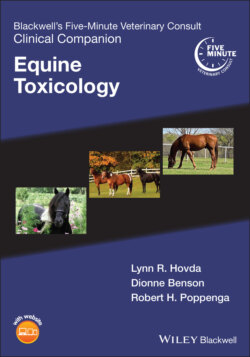Читать книгу Blackwell's Five-Minute Veterinary Consult Clinical Companion - Группа авторов - Страница 64
ОглавлениеChapter 7 Cocaine
DEFINITION/OVERVIEW
A white pearlescent powder in its purest form, usually present as a hydrochloride salt. The street drug typically looks like a fine, white, crystalline powder and often contains substances such as cornstarch, talcum powder, or flour as extenders. Occasionally other drugs such as caffeine, levamisole, fentanyl, aminorex, or amphetamines are mixed with the cocaine.
“Crack” cocaine is the freebase form that has been precipitated into rocks that can be smoked.
Schedule II drug used for local anesthesia, where vasoconstriction may be advantageous.
Cocaine is a tropane alkaloid obtained from leaves of shrubs in the genus Erythroxylaceae, which are domesticated tropical plants native to the Amazon and the eastern slope of the Andes in Bolivia and Peru.
Although the active ingredient, cocaine, was only isolated in 1859 by German chemist Albert Niemann, the coca leaves have been used for both medicinal and recreational purposes by the native populations in South American for thousands of years.
Cocaine is the only naturally occurring local anesthetic. It is also one of the most abused drugs in the world.
Because of its use as a recreational drug and its powder formulation, residues of cocaine are occasionally found in blood and urine samples collected from horses in drug and medication control programs.
Prohibited substance under USEF, FEI, AQHA, and ARCI regulations.
ETIOLOGY/PATHOPHYSIOLOGY
Mechanism of Action
The pharmacodynamics of cocaine involve the complex relationships of multiple neurotransmitters.
It directly prevents the re‐uptake of dopamine, serotonin, and norepinephrine into presynaptic neurons.
Like other local anesthetics, it produces direct effects on cell membranes – cocaine blocks sodium channel activity and thus prevents the generation and conduction of nerve impulses in electrically active cells, such as myocardial and nerve cells.
Toxicokinetics
Cocaine has not been well studied in the horse. Based on the scientific literature examining the effects of cocaine in other species, however, in the horse one would expect it to be well absorbed when administered via mucous membranes (e.g. intranasally) or the GI tract.
In humans, peak concentrations occur within 5–10 minutes of smoking and within 60 minutes of intranasal administration.
Some cocaine is excreted unchanged in the urine, but the vast majority is metabolized to benzoylecgonine, ecgonine methyl ester, norcocaine and other metabolites.
Although cocaine has a short elimination half‐life, the half‐lives of cocaine metabolites are substantially longer.
Toxicity
The lethal dose for cocaine in horses has not been determined and there are no reports of acute toxicity in the scientific literature.
In mice the LD50 is reported to be 96 mg/kg following oral administration.
In humans, recreational cocaine abusers typically have peak serum concentrations between 0.5 and 5 μM, but lethal toxicity has been observed with serum concentrations of cocaine of 10 μM.
Systems Affected
Neurological – ataxia, disorientation, euphoria, agitation, anxiety, seizures.
Cardiovascular – tachydysrhythmia, severe hypertension, acute coronary syndrome in humans, stroke.
Musculoskeletal – hyperthermia, cocaine‐induced rhabdomyolysis.
SIGNALMENT/HISTORY
Risk Factors
Accidental ingestion is unlikely.
Illicit administration for performance‐enhancing effects in racehorses could occur.
Inadvertent exposure from by a human abuser or from a contaminated environment is theoretically possible.
Historical Findings
Owners and trainers may be reluctant to admit possession and use.
In many cases, the source may not be identified.
Location and Circumstances of Poisoning
Worldwide problem, not just limited to the United States.
Intentional exposure by direct administration to horse.
Unintentional exposure by careless placement of product or inadvertent transfer from personnel could theoretically cause detectable concentrations of cocaine or its metabolites to be present in blood and urine samples, but toxic concentrations are unlikely.
CLINICAL FEATURES
With pharmacologically significant doses:CNS stimulation.Tachycardia.Arrhythmias.Bilateral mydriasis.Increased locomotor activity.
Many exposures are not pharmacologically significant, although they produce detectable concentrations of cocaine metabolites in urine and blood samples.
DIFFERENTIAL DIAGNOSIS
CNS stimulants (amphetamines, methamphetamine).
High doses of beta2‐adrenergic agonists.
High doses of caffeine or other methylxanthines.
DIAGNOSTICS
CBC/Serum Chemistry/Urinalysis
BUN, creatinine, and creatine kinase for evidence of rhabdomyolysis
Serum Samples/Urine Samples
Immunoassay screening.
LC‐MS.
Other Diagnostic Tests
ECG as needed for tachydysrhythmia and cardiac effects.
Pathological Findings
None reported in the horses, but from other species, if dose was high enough one would predict:Myocardial necrosis and hemorrhage.Pulmonary hemorrhage.
THERAPEUTICS
Appropriate Health Care
Monitor ECG and treat arrhythmias.
Maintain blood volume, pH, and electrolyte balance.
Monitor for hyperthermia.
Avoid CNS stimulation; dark quiet stall if possible.
Antidotes
No specific antidote.
Drugs of Choice
IV fluids as needed.
For excitation:Detomdine 20–40 μg/kg IV.Romifidine 40–120 μg/kg IV.
Control life‐threatening cardiac arrhythmias:Propranolol 0.02 mg/kg IV slowly, maximum of 1 mg/kg.Esmolol CRI 25–75 μg/kg/min.
Precautions/Interactions
Ethanol potentiates the effects and may increase the risk of toxicity.
Protection of the head and limbs may be necessary with excitation.
COMMENTS
Client Education
LC‐MS may be useful in legal cases.
Prevention/Avoidance
Prevent exposure to illegal drugs.
Keep animals away from illegal drugs.
Educate trainers/riders/grooms of the risk of low‐level contamination.
Avoid access to illegal drugs.
Expected Course and Prognosis
Acute fatal toxicity has not been reported. Toxic effects would likely reside within hours.
Abbreviations
See Appendix 1 for a complete list.
Suggested Reading
1 Kollias‐Baker C, Maxwell L, Stanley S, Boone T. Detection and quantification of cocaine metabolites in urine samples from horses administered cocaine. J Vet Pharmacol Ther. 2003; 26(6):429–434.
2 Richards JR, Hollander JE, Ramoska EA, et al. β‐Blockers, cocaine, and the unopposed α‐stimulation phenomenon. J Cardiovasc Pharmacol Ther 2017; 22(3):239–249.
3 Zimmerman JL. Cocaine intoxication. Crit Care Clin 2012; 28(4):517–526.
Author: Cynthia Cole, DVM, PhD, DACVCP
Consulting Editor: Dionne Benson, DVM, JD
